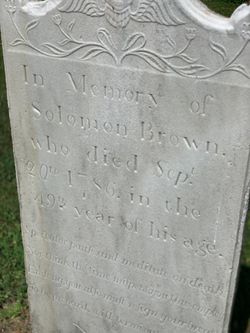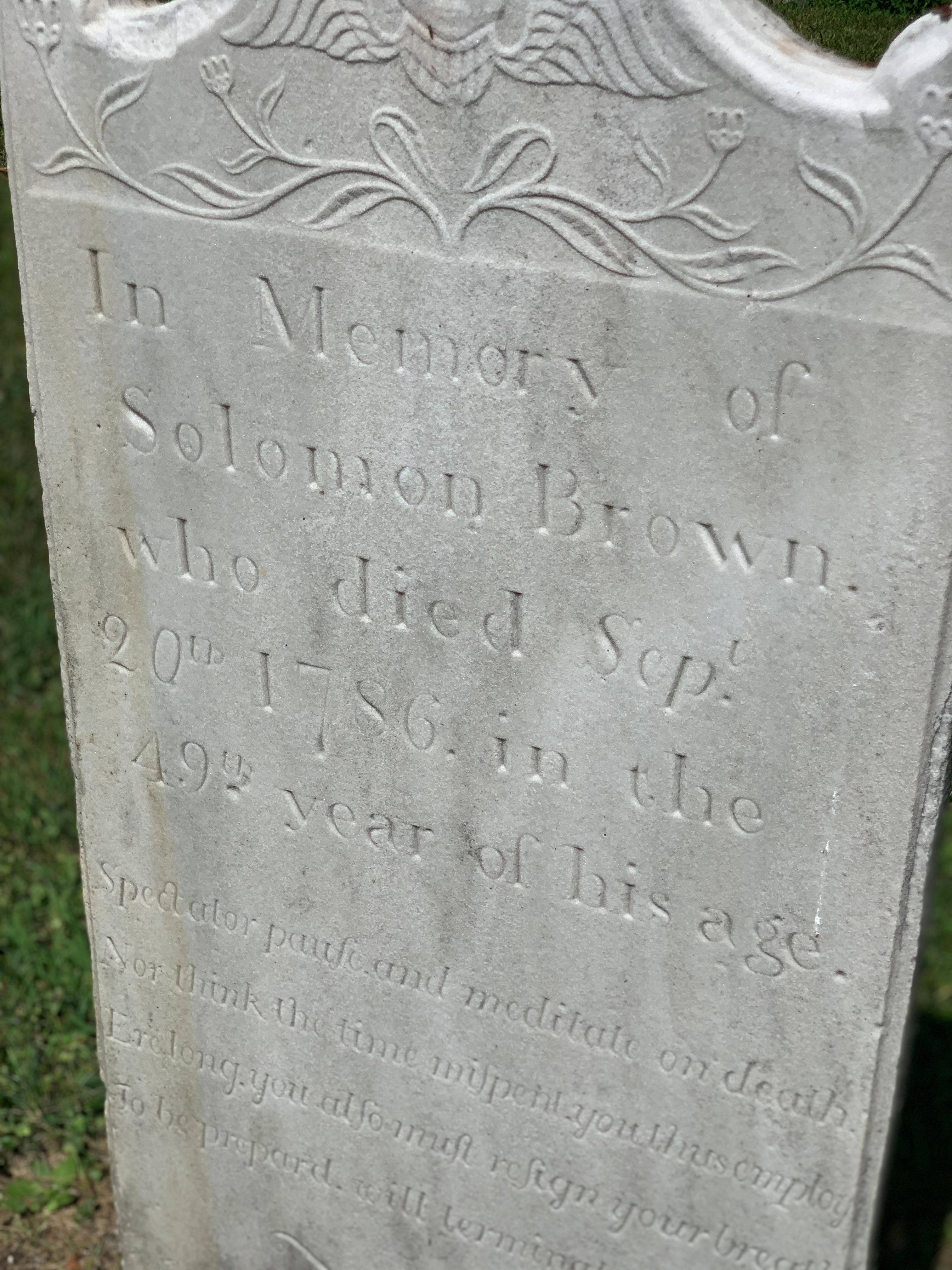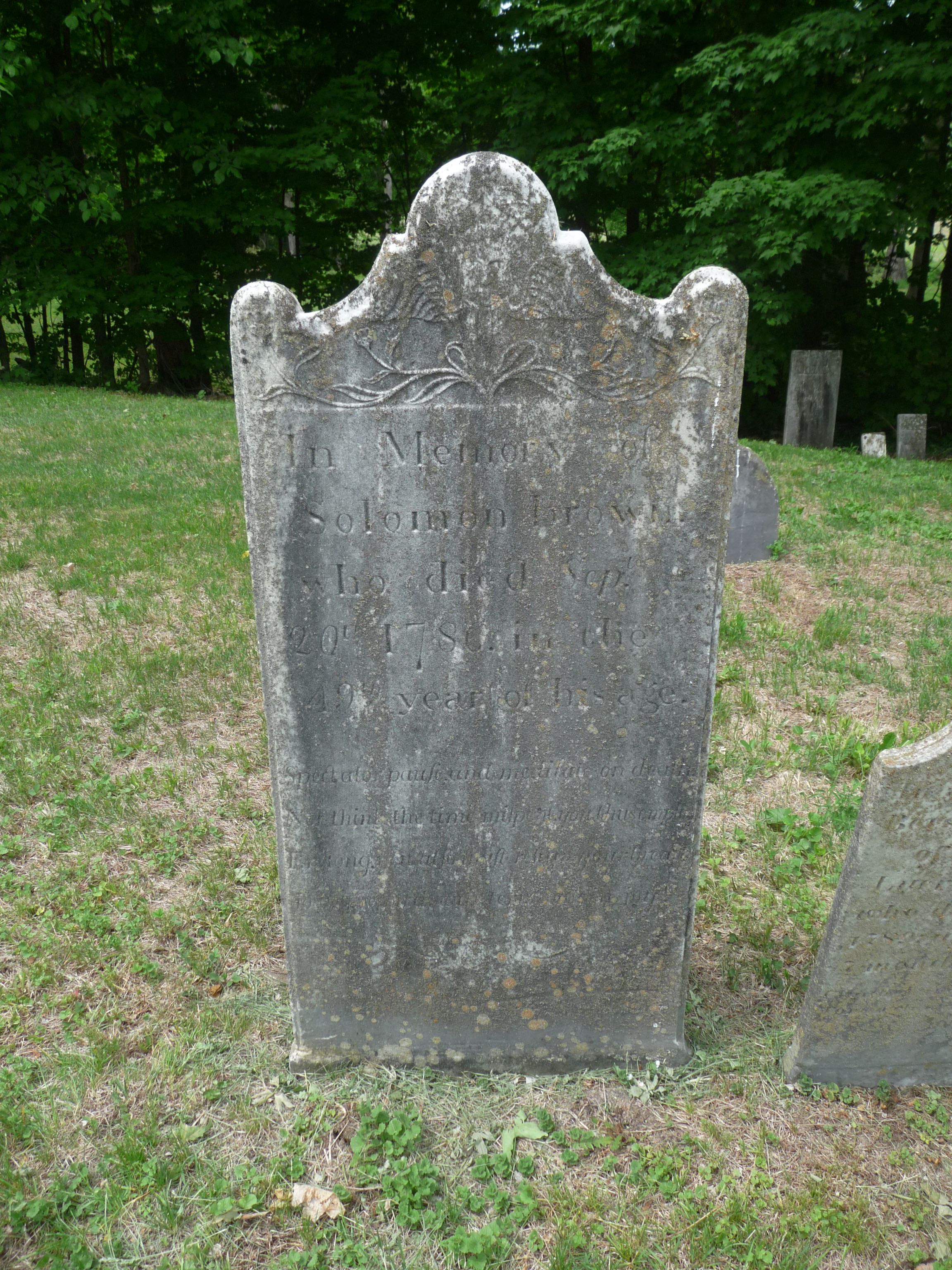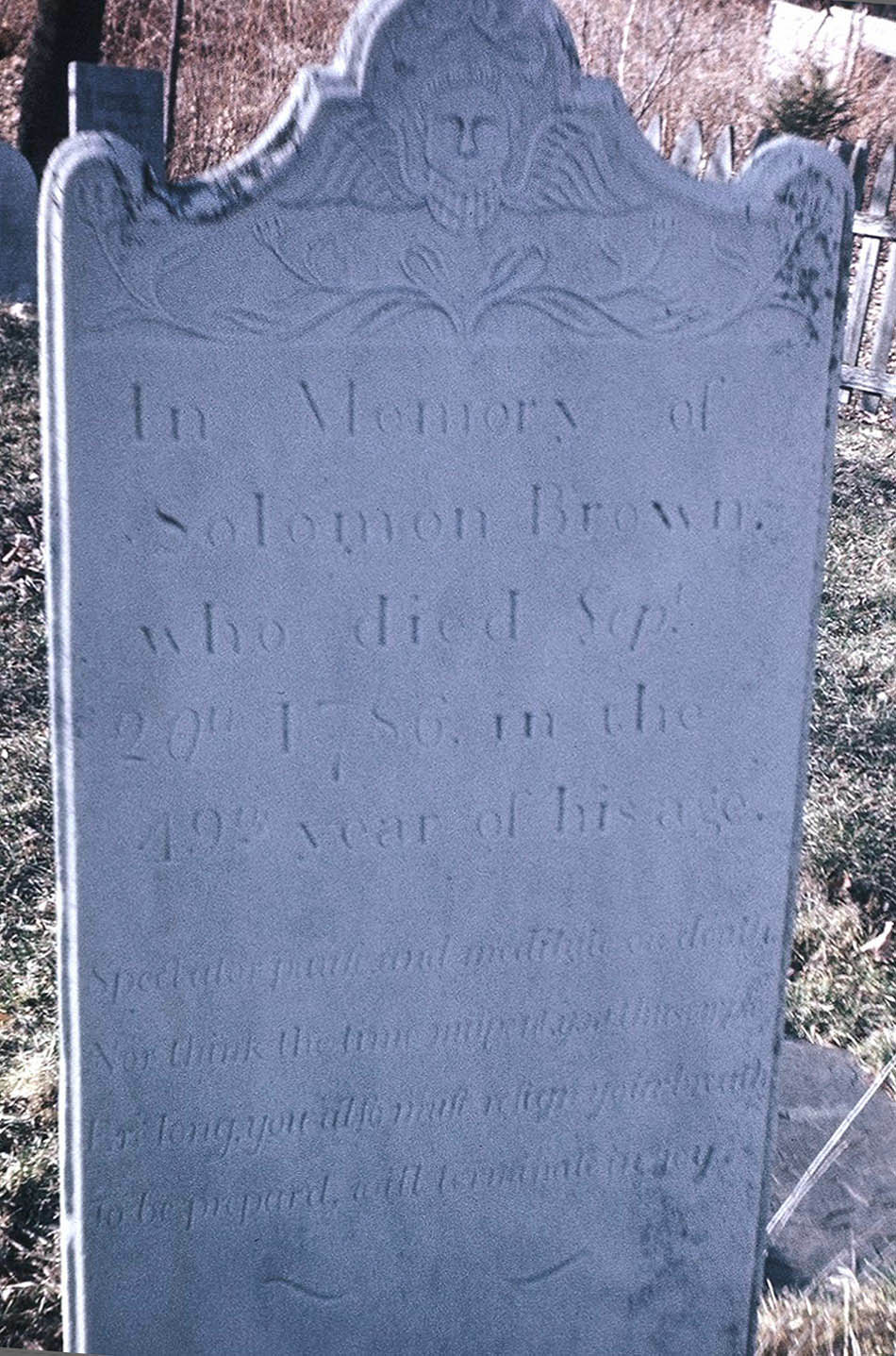In early 1739, at the age of 2 years, Solomon moved with his parents from residing on land called the Gore lying between the towns of Worcester and Oxford in Worcester County, Province of Massachusetts Bay to the town of Blandford in Hampshire (now Hampden) County, Province of Massachusetts Bay.
On April 22, 1756, at the age of about 16 years, Solomon either enlisted or was impressed out of Colonel John Worthington's South Militia Regiment of Hampshire County, Province of Massachusetts Bay for service in the expedition against Crown Point on Lake Champlain in the Province of New York at the order of His Excellency William Shirley, Esq. Solomon served as a Private in Captain John Mosley's Company, Colonel Joseph Dwight's Regiment during the French and Indian War (Seven Years War) Campaign of 1756. When Captain Mosely's Company was mustered at Fort William Henry at the southern end of Lake George in the Province of New York on October 11, 1756, Solomon was reported sick at Fort Edward. He was discharged from this service, November 28, 1756.
During the alarm of August 1757, Solomon served as a Private for 18 1/3 days and marched 130 miles in Lieutenant David Black's Blandford Company in the South Militia Regiment of Hampshire County, Province of Massachusetts Bay for the relief of the Fort William Henry Garrison at the southern end of Lake George in the Province of New York.
On April 11, 1759, Solomon Brown of Blandford was impressed as a Private out of the South Regiment in the County of Hampshire, Massachusetts Bay Colony into Captain Bancroft's Company, the 2nd Battalion, Brigadier General Timothy Ruggle's Brigade, put under the immediate command of Major-General Jeffery Amherst, Esq., Commander in Chief of His Majesty's Forces in North America, for the invasion of Canada.
Solomon married, June 18, 1759 at Blandford, Jean Anderson (Andeson) (1739-1802) by whom he had 10 children (9 sons and 1 daughter): William (1760-1805), Silas (1761-1840), Solomon (1763-1837), Samuel (1765-1829), John (1767-1846), David (1769-1855), Seth (1771-1840), Mary (Polly) (1777-1847), Joseph (1778-1857), and Levi (1781-1817).
Solomon was appointed to the Blandford Committees of Inspection, Correspondence and Safety, December 9, 1774, September 1776, and March 3, 1777. In January 1776, Solomon assisted in the movement of the cannon being moved under the direction of General Henry Knox from Fort Ticonderoga and Crown Point to Boston. Solomon, provided one of the two Oxen teams Knox hired to move the cannon from Blandford down the "tremendous Glasgow or Westfield mountain" to Westfield. Solomon received of General Knox 18 shiilings for carrying a Cannon weighing 24C.3 from Blandford 11 miles to Westfield.
On April 26, 1776, Solomon was commissioned 2nd Lieutenant of Captain William Knox's (6th) Company, Colonel John Mosley's 3rd Hampshire County Militia Regiment. Later that year (September 22 - November 16, 1776), Solomon served as 2nd Lieutenant in Captain William Cooley's Company, Colonel John Mosley's Militia Regiment marched to North Castle, Westchester County, New York. "The Battle of White Plains" occurred in North Castle October 28, 1776. The battle was a series of short skirmishes between General George Washington's small American army and General William Howe's much larger British & Hessian force. Although the British eventually won the confrontation, forcing Washington's troops to retreat, Howe never followed up this advantage by pursuing and capturing the American army. Thus, the battle served as a delaying action that allowed Washington's troops to withdraw. As a result, many historians feel that the battle marked an important turning point in the war.
From July 1st to the 31st, 1777, Solomon served as a Corporal in Captain Stephen Smith's Company, Colonel Benjamin Simon's (Berkshire County) Militia Regiment, serving in the Northern Department (July 1-31, 1777). While stationed at Manchester, in the New Hamsphire Grants, he enlisted as a Private in Captain John Warner's Company, Lieutenant Colonel Samuel Herrick's Vermont Regiment of Rangers as served in that capacity from July 21, 1777 - December 3, 1777). He was in the Battle of Bennington, August 16, 1777.
When Captain Knox, commander of the 6th Company of Colonel John Mosley's 3rd Hampshire County Militia Regiment, resigned his commission in early 1779 on account of age, lameness and infirmity, Solomon was commissioned Captain of the same Company, May 31, 1779. Two months later, July 31, 1779, Solomon served as Captain commanding the 6th Company of Colonel Elisha Porter's (Hampshire County) Militia Regiment which served at New London, Connecticut.
Sometime in 1780 or early 1781, Solomon and his family moved from Blandford, Massachusetts to White-Creek, alias New Perth, Charlotte (now Salem, Washington) County, New York where his 10th and last child was born.
On June 16, 1781, the Vermont General Assembly approved the Western Union (taking Western Territory into the State). On June 26, 1781, 10 days after The Vermont General Assembly establish the Western Union, it appointed Captain Solomon Brown to warn Town Meetings for the Town of White-Creek, alias New-Perth (now Salem, Washington County, New York). On the same day, the General Assembly formed the 15th Regiment of Militia and called the Regiment to choose their Field and Staff Officers in order that each of them be duly commissioned. Solomon was elected and commissioned Lieutenant Colonel of the 15th Vermont Militia Regiment and served in that capacity for 11 days under Colonel Gideon Warren when the 15th Regiment was called up in October 1781 for the defence of the Frontiers of the State of Vermont.
References:
(1) "Ulster Scots and Blandford Scouts" by Sumner Gilbert Wood, 1928, pages 381-384, 390-391, and 399-400
(2) Mss Massachusetts Archives Collection: Volume 94 pages 125, 153-154, 417, 536, & 549-550; Volume 95 page 552; Volume 97 pages 178 & 236-137; Volume 98 pages 186-187; and Volume 99 page 142
(3) "Soldiers and Sailors of the Revolution from Blandford, Massachusetts" by Sumner Gilbert Wood, 1933, pages 11, 20, 37-38, and 40
(4) "Rolls of the Soldiers in the Revolutionary War 1775 to 1783" by John E. Goodrich, 1904, pages 48 and 587
(5) "State Papers of Vermont - Volume Three - Journals and Proceedings (Vol. I) of the General Assembly of the State of Vermont" 1778-1781, by Walter H. Crockett, 1924, pages 242, and 251
(6) "Records of the Governor and Council of the State of Vermont" Vol II (1779-1782), by E. P. Walton, 1874, page 306
(7) "Laws of Vermont - State Papers of Vermont" Vol 13 (1781-1784), by John A. Williams, 1965, pages 47-49
(8) "The Gravestone Inscriptions of Rupert Bennington County, Vermont" by Levi Henry Elwell, 1913, page 42.
In early 1739, at the age of 2 years, Solomon moved with his parents from residing on land called the Gore lying between the towns of Worcester and Oxford in Worcester County, Province of Massachusetts Bay to the town of Blandford in Hampshire (now Hampden) County, Province of Massachusetts Bay.
On April 22, 1756, at the age of about 16 years, Solomon either enlisted or was impressed out of Colonel John Worthington's South Militia Regiment of Hampshire County, Province of Massachusetts Bay for service in the expedition against Crown Point on Lake Champlain in the Province of New York at the order of His Excellency William Shirley, Esq. Solomon served as a Private in Captain John Mosley's Company, Colonel Joseph Dwight's Regiment during the French and Indian War (Seven Years War) Campaign of 1756. When Captain Mosely's Company was mustered at Fort William Henry at the southern end of Lake George in the Province of New York on October 11, 1756, Solomon was reported sick at Fort Edward. He was discharged from this service, November 28, 1756.
During the alarm of August 1757, Solomon served as a Private for 18 1/3 days and marched 130 miles in Lieutenant David Black's Blandford Company in the South Militia Regiment of Hampshire County, Province of Massachusetts Bay for the relief of the Fort William Henry Garrison at the southern end of Lake George in the Province of New York.
On April 11, 1759, Solomon Brown of Blandford was impressed as a Private out of the South Regiment in the County of Hampshire, Massachusetts Bay Colony into Captain Bancroft's Company, the 2nd Battalion, Brigadier General Timothy Ruggle's Brigade, put under the immediate command of Major-General Jeffery Amherst, Esq., Commander in Chief of His Majesty's Forces in North America, for the invasion of Canada.
Solomon married, June 18, 1759 at Blandford, Jean Anderson (Andeson) (1739-1802) by whom he had 10 children (9 sons and 1 daughter): William (1760-1805), Silas (1761-1840), Solomon (1763-1837), Samuel (1765-1829), John (1767-1846), David (1769-1855), Seth (1771-1840), Mary (Polly) (1777-1847), Joseph (1778-1857), and Levi (1781-1817).
Solomon was appointed to the Blandford Committees of Inspection, Correspondence and Safety, December 9, 1774, September 1776, and March 3, 1777. In January 1776, Solomon assisted in the movement of the cannon being moved under the direction of General Henry Knox from Fort Ticonderoga and Crown Point to Boston. Solomon, provided one of the two Oxen teams Knox hired to move the cannon from Blandford down the "tremendous Glasgow or Westfield mountain" to Westfield. Solomon received of General Knox 18 shiilings for carrying a Cannon weighing 24C.3 from Blandford 11 miles to Westfield.
On April 26, 1776, Solomon was commissioned 2nd Lieutenant of Captain William Knox's (6th) Company, Colonel John Mosley's 3rd Hampshire County Militia Regiment. Later that year (September 22 - November 16, 1776), Solomon served as 2nd Lieutenant in Captain William Cooley's Company, Colonel John Mosley's Militia Regiment marched to North Castle, Westchester County, New York. "The Battle of White Plains" occurred in North Castle October 28, 1776. The battle was a series of short skirmishes between General George Washington's small American army and General William Howe's much larger British & Hessian force. Although the British eventually won the confrontation, forcing Washington's troops to retreat, Howe never followed up this advantage by pursuing and capturing the American army. Thus, the battle served as a delaying action that allowed Washington's troops to withdraw. As a result, many historians feel that the battle marked an important turning point in the war.
From July 1st to the 31st, 1777, Solomon served as a Corporal in Captain Stephen Smith's Company, Colonel Benjamin Simon's (Berkshire County) Militia Regiment, serving in the Northern Department (July 1-31, 1777). While stationed at Manchester, in the New Hamsphire Grants, he enlisted as a Private in Captain John Warner's Company, Lieutenant Colonel Samuel Herrick's Vermont Regiment of Rangers as served in that capacity from July 21, 1777 - December 3, 1777). He was in the Battle of Bennington, August 16, 1777.
When Captain Knox, commander of the 6th Company of Colonel John Mosley's 3rd Hampshire County Militia Regiment, resigned his commission in early 1779 on account of age, lameness and infirmity, Solomon was commissioned Captain of the same Company, May 31, 1779. Two months later, July 31, 1779, Solomon served as Captain commanding the 6th Company of Colonel Elisha Porter's (Hampshire County) Militia Regiment which served at New London, Connecticut.
Sometime in 1780 or early 1781, Solomon and his family moved from Blandford, Massachusetts to White-Creek, alias New Perth, Charlotte (now Salem, Washington) County, New York where his 10th and last child was born.
On June 16, 1781, the Vermont General Assembly approved the Western Union (taking Western Territory into the State). On June 26, 1781, 10 days after The Vermont General Assembly establish the Western Union, it appointed Captain Solomon Brown to warn Town Meetings for the Town of White-Creek, alias New-Perth (now Salem, Washington County, New York). On the same day, the General Assembly formed the 15th Regiment of Militia and called the Regiment to choose their Field and Staff Officers in order that each of them be duly commissioned. Solomon was elected and commissioned Lieutenant Colonel of the 15th Vermont Militia Regiment and served in that capacity for 11 days under Colonel Gideon Warren when the 15th Regiment was called up in October 1781 for the defence of the Frontiers of the State of Vermont.
References:
(1) "Ulster Scots and Blandford Scouts" by Sumner Gilbert Wood, 1928, pages 381-384, 390-391, and 399-400
(2) Mss Massachusetts Archives Collection: Volume 94 pages 125, 153-154, 417, 536, & 549-550; Volume 95 page 552; Volume 97 pages 178 & 236-137; Volume 98 pages 186-187; and Volume 99 page 142
(3) "Soldiers and Sailors of the Revolution from Blandford, Massachusetts" by Sumner Gilbert Wood, 1933, pages 11, 20, 37-38, and 40
(4) "Rolls of the Soldiers in the Revolutionary War 1775 to 1783" by John E. Goodrich, 1904, pages 48 and 587
(5) "State Papers of Vermont - Volume Three - Journals and Proceedings (Vol. I) of the General Assembly of the State of Vermont" 1778-1781, by Walter H. Crockett, 1924, pages 242, and 251
(6) "Records of the Governor and Council of the State of Vermont" Vol II (1779-1782), by E. P. Walton, 1874, page 306
(7) "Laws of Vermont - State Papers of Vermont" Vol 13 (1781-1784), by John A. Williams, 1965, pages 47-49
(8) "The Gravestone Inscriptions of Rupert Bennington County, Vermont" by Levi Henry Elwell, 1913, page 42.
Inscription
In Memory of
Solomon Brown.
who died Sept.
20th 1786, in the
49th year of his age.
Spectator pause, and meditate on death,
Nor think the time mispent. you thus employ
Ere long, you also must resign your breath
To be prepar'd, will terminate in joy.












